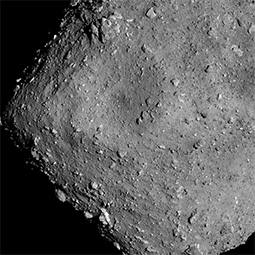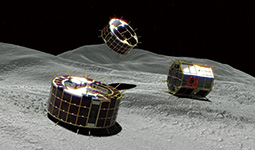February 2020
Unraveling the Origins of Earth and Life

Hayabusa2, an asteroid explorer, reached the surface of the asteroid Ryugu in 2019, successfully collecting samples which hold the key to unraveling the origins of both our solar system and life on Earth. As of January 2020, Hayabusa2 has completed its grand mission and is en route back to Earth.

Hayabusa2 was launched in December 2014. In June 2018, it finally arrived at the asteroid Ryugu, roughly 300 million kilometers from Earth. It spent one year and five months around the 1,000-meter-diameter asteroid, completing a number of missions before bidding farewell and setting off on its return trip to Earth in November 2019.
“In short, the project’s aim is to collect surface samples from the asteroid and bring them back to Earth. Hayabusa2 inherited this mission from its predecessor Hayabusa, which was launched in 2003,” explains Yoshikawa Makoto, Hayabusa2 Mission Manager at the Japan Aerospace Exploration Agency (JAXA).
Hayabusa was a spacecraft that landed on the asteroid Itokawa, roughly 320 million kilometers from Earth. It became the world’s first spacecraft to land on a celestial body other than the moon, collect a sample and return to Earth with it. The journey was incredibly risky, with its seven-year return to Earth now heralded as a miracle, having overcome communications blackouts, engine failure and other troubles.
“Hayabusa met with a number of unforeseen issues, because returning an asteroid sample to Earth had never before been attempted. With Hayabusa2, however, we dramatically improved the space probe’s performance and our operational capacity by subjecting the craft to rigorous testing based on those situations encountered by Hayabusa. So far, we haven’t had any major issues, and from what we can tell from photos and video footage, sample collection went off without a hitch,” says Yoshikawa.
But why is Hayabusa2 bringing asteroid samples back to Earth? The main goal is to analyze the samples, shedding light on the basic building blocks of our planet and the life on it, and the birth and evolution of our solar system. When the solar system was born 4.6 billion years ago, so was our Earth. The building blocks of Earth were melted when Earth was formed, so we cannot know what the building blocks of Earth were just by studying the material of the current Earth. Asteroids in our solar system like Ryugu, however, remain largely unchanged from the time of the solar system’s birth. It is highly likely that the basic building blocks which formed our Earth and the rest of the solar system remain on these asteroids.
On this mission, the Hayabusa2 touched down on Ryugu twice to obtain samples. This was done by firing a 5 g metallic projectile into Ryugu’s surface at high speed at the moment of arrival, with samples obtained from among floating material displaced by the collision. Before the second touchdown, Hayabusa2 succeed in creating the world’s first man-made crater on an asteroid, roughly 10 meters across and 2–3 meters deep, by firing a 2 kg copper lump at Ryugu from high altitude—about 300 meters away. The second touchdown was made close to this crater. Experts predict that with this touchdown, Hayabusa2 successfully collected subsurface samples of the asteroid, from a place not affected by sunlight or radiation.

Aside from the sample collection, Hayabusa2 also succeeded in deploying two rovers developed by JAXA. The rovers were automated, taking photographs as they hopped along the asteroid’s surface. In addition, Hayabusa2 dropped off a small lander called MASCOT, jointly developed between Germany and France, which took detailed photographs of the surface and measured surface temperature and magnetic fields.

“Our organization’s budget size pales in comparison to NASA (The National Aeronautics and Space Administration) or ESA (The European Space Agency). Yet even so, we have gone where no man has gone before in terms of asteroid exploration. This has led Western researchers to take great interest in Hayabusa2. In particular, our singular technology and operational capacity which enables pinpoint landing on asteroids may find wide application in future aeronautical development undertaken by international cooperatives,” says Yoshikawa.
Hayabusa2 will return to Earth around the end of 2020, after a long, six-year journey. If the collected samples can be analyzed, they may provide a clue towards solving the great mystery of where our solar system and life on this planet originated.

